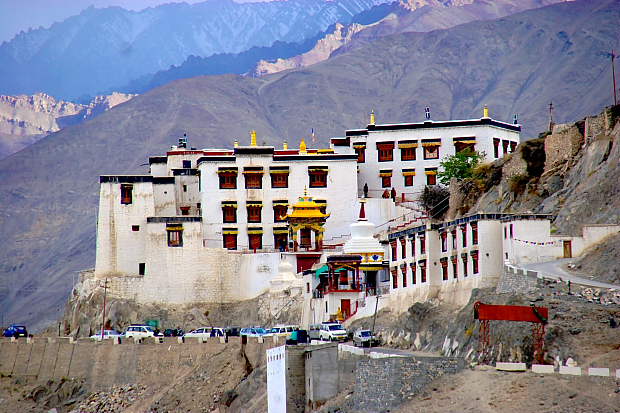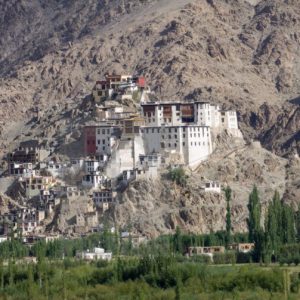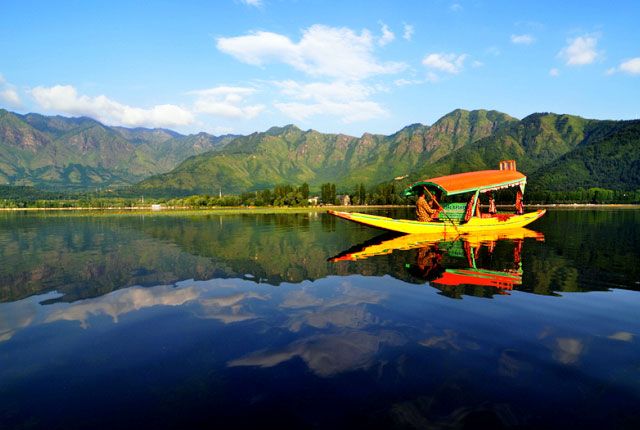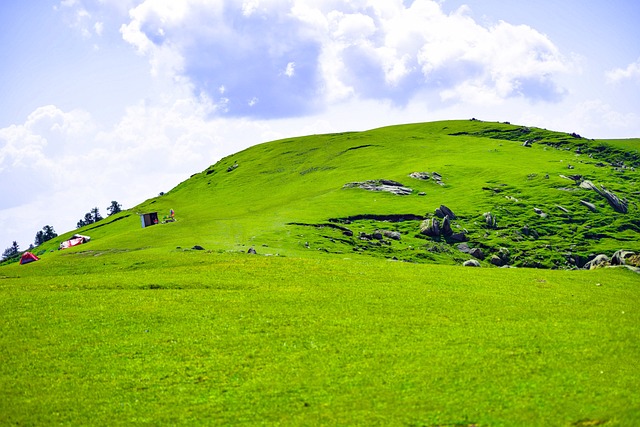
Spituk Monastery : Whispers of Wisdom
Table of Contents
ToggleOverview
Ladakh- Land of High Passes, is a Magical Fusion of Culture, Spirituality, and Natural Beauty is an ideal destination for the serious traveler looking for peace and excitement. Among many beautiful Buddhist monasteries scattered across the region, Spituk Monastery ranks as a spiritually and culturally more vital landmark. This monastery, located just 8 kilometers from the capital of Ladakh, Leh, provides a glimpse into the life of Buddhism and onto the soul-stirring beauty of the Ladakhi landscape.
This high-altitude monastery, with a deep scenic view of mountains, represents a blend of history, architecture, spiritual practice, and spectacular vistas that will fill any imagination-from an architecture enthusiast to a Buddhist scholar or a visitor seeking peace in the Himalayas.
In this blog, we are going to take you through history, architecture, religious significance, festivals, and all practical travel tips for visiting the Spituk Monastery. We also check its connection with Ladakhi culture and why it is one of the must-visit monasteries in Ladakh.





History of Spituk Monastery
Spituk Monastery is an institution that was founded a long time back in the 11th century by a powerful Buddhist guru by the name of Od-de, or Lama Lhawang who came to be known as Lama Spituk. Historical records and the locals believe it was founded long back as a seat of the Gelugpa school of Buddhism, with which the Dalai Lama and other such important Buddhist gurus have traditionally identified. The Gelugpa sect is known for its love for studying different dimensions of Buddhist philosophy and meditation techniques.
The location atop the hill offers a visual prospect of the Indus Valley as exorbitantly spectacular, standing as a symbol of the heights to which Buddhists aspire. Isolated in the world, the remote and awesome setting for Spituk suited it well as an ideal location for meditation and spiritual practice.
It remained a spiritual center as well as a cultural institution for centuries and was renovated and enlarged in the 15th century by King Jamyang Namgyal of Ladakh, who also propagated Buddhism.
Literally meaning “exemplary” or “best”, this place, Spituk Monastery is more than a treasure of the past. It is one of the chief Buddhist monasteries in Ladakh and represents nearly a thousand years of continuous religious activity.
Importance of the Monastery in Ladakhi Buddhism
The Spituk monastery falls in the Gelugpa tradition, which makes it spiritually important in the monastery. The Spituk is a seat for a prominent religious figure named the Spituk Lama within Ladakh. The monks at Spituk Monastery commit themselves to some studies of Buddhist teachings and meditation practices highlighting compassion, wisdom, and mindfulness.
This monastery plays an important role in the religious lives of the people of Ladakh. It is often visited by pilgrims and travelers to seek some kind of blessing, offering prayer ceremonies with rituals and explaining Buddhist philosophy. The Tibetan Buddhist culture at the monastery is very well preserved.
But, what makes Spituk noteworthy is that it is a significant depository of ancient Buddhist texts and scriptures, most of which is available in the library of the monastery in excellent preservation for generations to come. In respect to this exercise of preserving sacred teachings, the present day bequeaths dedication to it, which makes it a living testament to the rich history of the region’s spiritual exercises.
Spituk Monastery Architecture
Tradition combined with innovation
Spituk Monastery is built on a steep slope. From that cliff, the Indus River flows away into the distance. In this way, every architectural structure makes full utilization of the beauty that the landscape affords, such that Spituk Monastery is not only a religious place but a place for peace and reflection. Panoramic views of the Indus Valley, the Zanskar Range, and the Leh region can be had from the monastery.
The monastery complex is represented by several structures, ranging from prayer halls and temples to living quarters of monks and impressive exhibitions of Buddhist art. Buildings are constructed in the classic form of Tibetan architecture with whitewashed walls, red-and-gold decorations, and spacious roofed courtyards for meditation and contemplation in a prayerful mood.
Main Prayer Hall (Dukhang)
The main part of Spituk Monastery consists of its main prayer hall called Dukhang. This enormous prayer hall is utilized for daily prayers, various forms of religious ceremonies, and meditation. There are several beautifully decorated Buddha images inside the Dukhang with intricate mural paintings, which reflect some important scenes from Buddhist scriptures. Colorful thangkas decorate the walls. Thangkas are traditional Tibetan scroll paintings; sometimes they depict deities and bodhisattvas and a description of the life of the Buddha.
Inside the prayer hall, you would find the statue of the historical Buddha, Shakyamuni sitting in a meditative posture. The huge golden picture indicates peace and enlightenment along with compassion to the people who worship there. The rest of the small statues surrounding this represent other eminent Buddhist figures like the Bodhisattva of Compassion Avalokiteshvara and the savior that enabled Buddhism enter Tibet Padmasambhava.
The inside environment of the prayer hall is very calm and spiritual, giving an ideal ambiance for those who want to meditate or consider the Buddhist teachings. Regular chanting sessions and rituals are also conducted by the resident monks here especially during the Buddhistic festivals.
The Kali temple and the iconic statue in the monastery
Probably the most prominent feature of Spituk Monastery is the Kali temple, devoted to the Hindu goddess Kali. That is an unusual mix of Hindu and Buddhist practices together which signify the rich cultural influences in Ladakh-a state of Ladakh where there is harmony between both Buddhism and Hinduism. The Kali statue in the temple is a blood-thirsty figure with a blood-red color and a fierce expression that means good can outwit evil.
The monastic compound boasts the Kali statue of Spituk which happens to be one of the dramatic and most worshipped religious icons in the cloister and which the pilgrims and visitors come to seek spiritual renaissance.
Not to be missed is the magnificent statue of the Maitreya Buddha out on the grounds of the monastery from the prayer hall. The Maitreya Buddha is the Buddha of the future, and the existence of this statue expresses hope and optimism for generations to come. This makes one understand that Spituk continues working towards keeping the teachings of Buddhism alive while making peace and enlightenment sink in all of humanity.
Main Structures of the Monastery
Besides the main prayer hall and the temple of Kali, Spituk also has a number of other religious structures. Apart from these, meditation rooms, shrines, and a library holding various texts and scriptures of Buddhism abound within its premises. The quarters of monks in the monastery are simple but functionally designed for maintaining a quiet environment for study and contemplation.
Quite worth mentioning is the cover of stupas constructed over the monastery. According to some, these hold relics and sacred objects. In them, usual sites for chapels of prayer and ritual offerings exist. Many among the pilgrims who come to Spituk Monastery find it customary to walk around said stupas while chanting mantras.
Spiritual as well as Cultural Significance of Spituk Monastery
A Centre for Buddhist Learning and Practice
There are so many ways in which the Spituk Monastery has provided a great base for research and studies of Tibetan Buddhism over the years. The learned monks coming from Spituk have had a very good educational system in the philosophy of Buddhism. This is an educational school for both novices and experienced practitioners. Students come here to learn at Spituk the sacred Tibetan texts, such as sutras within Buddhist scripture, and discuss philosophical ideas.
It is extremely quiet and scholarly due to the devotional attitude of the monks in regard to their studies and practices. The pilgrims and visitors watch the monks performing their daily rituals and routine-cum-rituals like chanting, prayer, and meditation.
Religious Festivals and Celebrations
There are many Buddhist festivals performed all through the year, but the most popular one is the Spituk Gustor that takes place within the monasteries. The festival is held every year during the months of January or February. It is a highly religious affair to the locals. Spituk Gustor, which basically is a masked dance festival, is a colorful affair of the Cham dances performed by monks in elaborate costumes to ward off evil spirits and ensure good luck during the forthcoming year. These dances are said to be very symbolic in nature for the cleansing of the atmosphere and in the healing process, and to protect the community from evil powers.
The festival Spituk Gustor takes place at the monastery with a theme of bright colors, folk music, and cymbals, drums, and trumpets. The believers and the visitors come to the monastery to witness the spectacle and enjoy religious entertainment.
Other notable Buddhist festivals that take place here are Lhosar, or the Tibetan New Year, and Losar, which is a festival of the New Year of the Tibetan Buddhists. These festivals, accompanied by prayers and offerings coupled with the feast together, give a glorious glimpse of the spiritual and cultural wealth of Ladakh before the eyes of any visitor here.
Role of Spituk in the Ladakhi Culture
This is a storehouse of all Ladakhi cultural heritage speaking of Spituk Monastery owning up all the traditions, rituals, and faiths of Ladakhi Buddhism. In fact, this remains one of the most important roles that it has played within the spiritual framework of the Ladakhi community, especially as the people of Ladakh have been undergoing pressures from modernization in their religious and cultural practices.
All of this was inextricably related to the traditional Ladakhi way of life, closely interwoven with Buddhism, and rituals and practices executed at Spituk monastery reverberate with an eternal sense of devotion toward preserving and worshiping Buddhist teachings in everything that has to do with Spituk-from meditation and prayers to arts and craftsmanship exercised by the monks.
How to visit Spituk Monastery: Practical Information
How to get to Spituk Monastery
Spituk Monastery is about 8 km from Leh, the capital of Ladakh. You can hire a car or even a taxi. Enjoy the views of mountains on one side and valleys on the other as you pass through the route. It takes just 20 minutes from Leh if you hire a taxi or a motorcycle.
For the trekkers and explorers, there is a small trek up to the hill that takes visitors to the entrance of the monastery.
Best Time to Visit
Summer months are ideal to visit Spituk Monastery when the weather there remains pretty good and the roads are open. In the winter season, October to March, it snows highly in the region, and some of the areas are blocked with the snow in that period as well.
It is one of the colorful times to see there as it lets a witness of the Ladakhi Buddhist culture in all its glory.
Respective Custom
Respect and modest dressing are required to visit Spituk Monastery as the place itself is a worship venue. During such tours, do not be too noisy and take permission before clicking any photographs, especially in religious ceremonies.
Entry Fees
You can visit Spituk Monastery free, though visitors are invited to make donations in order to improve the monastery and activities carried out inside. When you visit don’t forget the small things such as butter lamps or prayer flags that actually symbolize much in Buddhist culture.
Conclusion
Indeed, the Spituk Monastery is the ultimate epitome of Ladakhi culture and Tibetan Buddhism. An abode with unlimited wealth in history, huge architecture, and deep spirituality, Spituk Monastery has always been at the top of the list of big treasures of Ladakh. Be it a sense of solace for asking questions about spiritual meaning, an exciting trek in the mountains, or further insight into the practices and philosophies of Tibetan Buddhism, the visitor leaves the place changed forever.
From the ancient statues to the colorful festivals and from the serene environment to the murals, this is a place that inspires contemplation, reflection and of course the deeper connecting with something greater than one’s self. Definitely not miss visiting this iconic monastery on your Ladakh trip and take back with you serenity and wisdom of one of the most important Buddhist monasteries in this region.
How to book Ladakh tour to visit Spituk Monastery?
Contact a travel agency that specializes in Kashmir tours. You can reach out to the following for assistance:
- Phone:
- +91 7889 655596
- +91 7006 891267
- Email:
Inquire about tour packages, itineraries, and pricing, and confirm your booking for a memorable winter experience!
People Also Ask
What is Spituk Monastery?
Spituk Monastery is a prominent Tibetan Buddhist monastery situated near Leh, in the Ladakh region of India. It belongs to the Gelugpa (Yellow Hat) sect of Tibetan Buddhism and is known for its beautiful architecture and scenic location overlooking the Indus Valley.
Where is Spituk Monastery located?
Spituk Monastery is located approximately 8 kilometers from Leh town, perched on a hilltop overlooking the Indus River. The monastery offers stunning panoramic views of the surrounding valleys and mountains.
What is the history of Spituk Monastery?
Spituk Monastery was founded in the 11th century by Od-de, a contemporary of the famous scholar Atisha. It has a rich history of Buddhist teachings and is a significant spiritual center in the Ladakh region.
What makes Spituk Monastery unique?
Spituk Monastery is unique for its location, perched on a hill with a view of the Indus Valley. It is also home to a large collection of ancient Buddhist scriptures, thangkas (Tibetan scroll paintings), and a reclining statue of Buddha. The monastery’s peaceful ambiance and its festivals are key attractions.
How do I reach Spituk Monastery?
Spituk Monastery is easily accessible from Leh by road. It is about a 15-20 minute drive from Leh town, and taxis or private vehicles are readily available to take you there. The road leading to the monastery is well-maintained.
What is the best time to visit Spituk Monastery?
The best time to visit Spituk Monastery is during the summer months (May to September) when the weather is mild, and the roads are open. Winter (October to March) can be extremely cold, with heavy snowfall in Ladakh, making travel difficult.
Is there an entry fee for Spituk Monastery?
There is generally a small entry fee (around ₹10 to ₹20) to visit Spituk Monastery. The fee helps with the maintenance of the monastery and supports the local community.
Can I take photos at Spituk Monastery?
Photography is allowed in the monastery’s outer areas, including the surroundings and the views of the Indus Valley. However, taking photos inside the prayer hall may be restricted, especially during ceremonies. It is advisable to ask for permission before photographing monks or sacred objects.
What are the key attractions of Spituk Monastery?
The key attractions of Spituk Monastery include:
- The huge statue of Buddha in the prayer hall
- Thangkas (paintings) depicting Buddhist deities and teachings
- The annual Spituk Gustor Festival
- The panoramic views of the Indus Valley
- The chapel with a collection of Buddhist scriptures and statues
What is the significance of Spituk Monastery in Buddhism?
Spituk Monastery is an important center of Gelugpa Buddhism in Ladakh and serves as a spiritual hub for monks and followers. It is believed to have been blessed by Atisha, a great Buddhist scholar, making it significant in Buddhist history and teachings.
Are there any festivals held at Spituk Monastery?
Yes, Spituk Gustor Festival is the main festival celebrated at the monastery. This annual festival, usually held in January or February, involves traditional mask dances, prayers, and rituals performed by the monks. It is an important cultural event in Ladakh.
Can I stay at Spituk Monastery?
While accommodation within the monastery is not available for tourists, there are several guesthouses, hotels, and homestays in Leh where you can stay during your visit. Some guesthouses near the monastery may offer basic lodging options.
What is the altitude of Spituk Monastery?
Spituk Monastery is situated at an altitude of approximately 3,300 meters (10,827 feet) above sea level, providing excellent views of the surrounding region.
Is Spituk Monastery open to tourists?
Yes, Spituk Monastery is open to tourists throughout the year, although it is most popular during the summer months. Visitors can explore the monastery, enjoy the serene atmosphere, and observe the monks in their daily practices.
What should I wear when visiting Spituk Monastery?
When visiting Spituk Monastery, it is recommended to wear modest clothing to respect local customs and the sacred environment. Comfortable shoes are also important as there may be some walking and steps to climb.
What is the climate like at Spituk Monastery?
Spituk Monastery experiences a cold desert climate with hot summers (up to 25°C to 30°C) and cold winters (below -20°C). The region is generally dry with very little rainfall, and temperatures can drop significantly, especially in winter.
Is Spituk Monastery suitable for spiritual retreats?
Yes, Spituk Monastery offers a peaceful and spiritual environment, making it suitable for quiet reflection and meditation. Visitors can observe the Buddhist rituals and learn more about Tibetan Buddhism in a tranquil setting.
Are there any trekking routes near Spituk Monastery?
Yes, there are several trekking routes in the vicinity of Spituk Monastery. One popular route is the Spituk to Zingchen trek, which passes through the scenic landscapes of Ladakh and offers a chance to experience local culture and wildlife.
Can I attend prayers or ceremonies at Spituk Monastery?
Yes, you can observe prayers and ceremonies at Spituk Monastery, and if you visit during a festival like the Spituk Gustor, you may even be able to attend the religious dances and rituals performed by the monks.
What are the local customs to be aware of at Spituk Monastery?
When visiting Spituk Monastery, it is important to:
- Dress modestly, covering shoulders and knees.
- Remove shoes before entering prayer halls or sacred areas.
- Walk clockwise around stupas, prayer wheels, and sacred shrines.
- Maintain silence and show respect to the monks and other visitors.
Can I buy souvenirs at Spituk Monastery?
While there are no major souvenir shops at Spituk Monastery, you can find small local stalls or vendors selling Buddhist artifacts, thangkas, and prayer wheels around the area. Leh market also has many shops where you can buy traditional handicrafts and souvenirs.
What is the architecture of Spituk Monastery like?
Spituk Monastery features traditional Tibetan Buddhist architecture, with a main prayer hall (gompa), rooftop prayer flags, statues of Buddha, and colorful murals depicting various deities. The monastery’s architecture blends harmoniously with the surrounding rugged mountains.
Is Spituk Monastery safe for tourists?
Yes, Spituk Monastery is safe for tourists. Leh Ladakh is generally a safe region for travelers. However, due to its high-altitude location, it is important to take precautions against altitude sickness and drink plenty of water during your visit.
What are the best nearby attractions to visit along with Spituk Monastery?
Nearby attractions include:
- Shanti Stupa: A stunning Buddhist monument offering panoramic views of Leh.
- Hemis Monastery: One of the largest and most famous monasteries in Ladakh.
- Magnetic Hill: A fascinating optical illusion where vehicles appear to roll uphill.
- Thiksey Monastery: A striking monastery known for its resemblance to the Potala Palace in Lhasa.
What should I pack when visiting Spituk Monastery?
When visiting Spituk Monastery, pack:
- Warm clothing for cooler temperatures, especially if visiting in autumn or winter.
- Sunscreen and sunglasses for protection from the sun.
- Comfortable walking shoes for walking around the monastery.
- Modest clothing for respectful visits to sacred sites.





Exploring Spituk Monastery with Golden Wheels Tour & Travels was an enlightening experience that I will cherish. The serene ambiance and ancient charm of Spituk Monastery were beautifully complemented by the knowledgeable guidance of Golden Wheels. They brought to life the monastery’s rich history, filled with legends and whispers of ancient wisdom, adding layers of meaning to each part of the visit.The team made sure we took in every detail—from the prayer halls to the breathtaking views overlooking the Indus River. The guides shared fascinating stories and insights that helped us appreciate the spiritual significance of the monastery, making the experience even more fulfilling. Golden Wheels’ well-organized tour allowed for a peaceful and unrushed experience, perfect for connecting with the monastery’s tranquility.If you seek a journey into the spiritual heart of Ladakh, Golden Wheels provides a smooth, insightful experience that leaves you with a deep sense of peace and awe. Highly recommended for anyone who wants to uncover the whispers of wisdom hidden within Spituk Monastery.
Our visit to Spituk Monastery was a highlight of our Leh trip, and Golden Wheels made it unforgettable. The monastery’s location on a hill offered stunning views of the valley. The guide provided fascinating insights into the history and spiritual significance of the place. It was a peaceful and spiritual experience. Highly recommend this tour!”
Spituk Monastery is a gem in Leh, and Golden Wheels made sure we experienced its beauty and serenity. The monastery’s architecture is breathtaking, and the panoramic views of Leh were incredible. The team’s professionalism and the insightful tour guide made the experience both educational and enriching. A must-visit!”
We thoroughly enjoyed our visit to Spituk Monastery with Golden Wheels. The drive up to the monastery was scenic, and once we arrived, the peace and tranquility of the place enveloped us. The guide was knowledgeable, sharing stories about the history of the monastery and its significance. It was an unforgettable experience!”
Golden Wheels provided an exceptional tour to Spituk Monastery. The monastery itself is beautiful and offers an incredible view of the Leh valley. The guide was very knowledgeable and gave us a deeper understanding of the place’s spiritual importance. We felt so peaceful and connected during our visit. Thank you, Golden Wheels!”
Visiting Spituk Monastery with Golden Wheels was an incredible experience. The breathtaking views of the valley and the surrounding mountains made the visit even more special. The guide was excellent, explaining the rich history and culture of the monastery. Golden Wheels made sure everything was well-organized and enjoyable.”
“Spituk Monastery is a hidden gem, and Golden Wheels made it a truly unforgettable visit. The serene atmosphere and stunning surroundings were perfect for reflection and peace. The guide was extremely knowledgeable, and the entire experience was smooth and enjoyable. We highly recommend this tour to anyone visiting Leh.”
Our visit to Spituk Monastery was an enriching experience, thanks to Golden Wheels. The monastery’s beauty and historical significance were brought to life by our guide’s informative commentary. The panoramic views were awe-inspiring, and we loved how peaceful the area was. Golden Wheels truly made this tour memorable
Golden Wheels gave us an unforgettable experience at Spituk Monastery. The monastery’s spiritual significance and its beautiful location in the Leh valley were highlights of our trip. The guide was attentive and passionate about the history, and we felt completely immersed in the culture and serenity of the place. Definitely a must-do!”